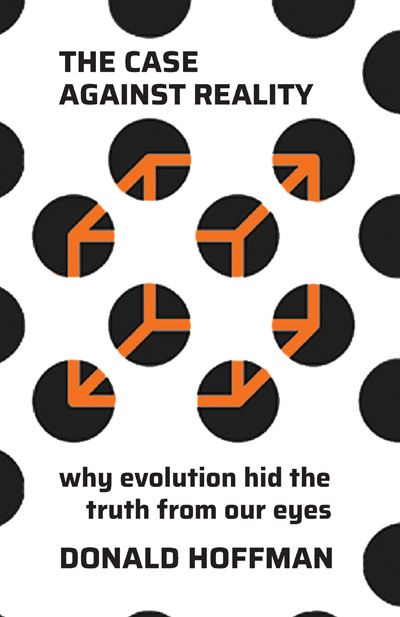SCIENCE SALON # 78
Michael Shermer with Dr. Donald Hoffman — The Case Against Reality: Why Evolution Hid the Truth From Our Eyes
In his new book, The Case Against Reality: Why Evolution Hid the Truth From Our Eyes, the U.C. Irvine cognitive scientist Dr. Donald Hoffman challenges the leading scientific theories that claim that our senses report back objective reality. How can it be possible that the world we see is not objective reality? And how can our senses be useful if they are not communicating the truth? Hoffman argues that while we should take our perceptions seriously, we should not take them literally. His evolutionary model contends that natural selection has favored perception that hides the truth and guides us toward useful action, shaping our senses to keep us alive and reproducing. We observe a speeding car and do not walk in front of it; we see mold growing on bread and do not eat it. These impressions, though, are not objective reality. Just like a file icon on a desktop screen is a useful symbol rather than a genuine representation of what a computer file looks like, the objects we see every day are merely icons, allowing us to navigate the world safely and with ease. The real-world implications for this discovery are huge, even dismantling the very notion that spacetime is objective reality. The Case Against Reality dares us to question everything we thought we knew about the world we see.
In this conversation, Hoffman and Shermer get deep into the weeds of:
- the nature of reality (ontology)
- how we know anything about reality (epistemology)
- the possibility that we’re living in a simulation
- the possibility that we’re just a brain in a vat
- the problem of other minds (that I’m the only sentient conscious being while everyone else is a zombie)
- the hard problem of consciousness
- what it means to ask “what’s it like to be a bat?”
- does the moon exist if there are no conscious sentient beings anywhere in the universe?
- is spacetime doomed?
- quantum physics and consciousness
- the microtubule theory of consciousness
- the global workspace theory of consciousness, and
- how Hoffman’s Interface Theory of Perception differs from Jordan Peterson’s Archetypal Theory of Truth (Shermer’s label for Peterson’s evolutionary theory of truth).
Listen to the podcast via Apple Podcasts, Spotify, Google Podcasts, Stitcher, iHeartRadio, and TuneIn.
Check Us Out On YouTube.
Science Salons • Michael Shermer
Skeptic Presents • All Videos
You play a vital part in our commitment to promote science and reason. If you enjoy the Science Salon Podcast, please show your support by making a donation.
![V-beam laser treatment for acne, by Alice Pien, M.D [CC BY-SA 4.0] (https://creativecommons.org/licenses/by-sa/4.0) via Wikimedia Commons (https://commons.wikimedia.org/wiki/File:V-beam-laser-acne-ama-regenerative-medicine.jpg)](https://www.skeptic.com/eskeptic/2019/images/19-08-13/V-beam-laser-acne-ama.jpg)
Lasers are everywhere and have many applications, from bar codes to printers, surgery to welding, entertainment to law enforcement, DVD players to pointers (great for giving lectures and for playing with cats). However, in this column from Skeptic magazine 24.2 (2019), Harriet Hall M.D. examines whether laser therapy is more hype than hope.
Laser Therapy: Hope or Hype and Hokum?
I love to watch TV reality shows about veterinarians. There are quite a few of them now. My favorite is “The Incredible Dr. Pol.” I learn a lot from them, for example that “polio” in goats means a vitamin deficiency disease, not the infectious disease that humans get. And I have learned that dogs don’t have blood types, so any dog can donate blood to any other dog. That’s good to know, but as a skeptic there are a few things on those shows that I question. I have frequently seen TV veterinarians use laser therapy to speed wound healing from both injuries and surgical incisions. I kept wondering “Is that for real? Is it based on science or superstition?” I decided to look into the evidence.
What are Lasers?
“Laser” stands for “Light Amplification by Stimulated Emission of Radiation.” Einstein established the theoretical foundation in a 1917 paper, and the first laser was built in 1960. Lasers emit coherent light that can be tightly focused and has a limited spectrum, emitting a single color of light. Output can be continuous or pulsed. A laser that produces light is technically an oscillator rather than an amplifier, and it has been suggested that the acronym LOSER — Light Oscillation by Stimulated Emission of Radiation — might have been a more correct acronym, although it is apparent why that didn’t catch on! Today, lasers are everywhere and have many applications, from bar codes to laser printers, from surgery to welding, from entertainment to law enforcement, from DVD players to laser pointers (great for giving lectures and for playing with cats). There are many types of lasers; they can use visible light or other electromagnetic frequencies, from infrared to X-rays and even gamma rays.
Lasers have many applications in medicine. In surgery, they can cut more precisely than scalpels and can stop bleeding. In cancer treatment, they have various uses that are supported by good scientific evidence. The evidence is not so clear for low-level lasers (cold lasers), which have been used for wound healing, smoking cessation, tuberculosis, temporomandibular joint (TMJ) disorders, carpal tunnel syndrome, fibromyalgia, osteoarthritis, rheumatoid arthritis, and much more. Cold lasers are even applied to mythical acupuncture points as “laser acupuncture.”
Veterinary Use
Lasers are widely used by veterinarians to facilitate wound healing, reduce inflammation, and treat musculoskeletal pain. Some veterinarians advocate laser treatment of allergic skin disease, infections, and envenomation (the process by which venom is injected by the bite or sting of a venomous animal); some claim they improve general health and enhance immune function and can even reverse “Qi-stagnation,” whatever that is! Veterinary studies are sparse, poorly designed, and the results are inconsistent. There are no systematic reviews of clinical trials validating laser therapy for specific indications in animals.1 […]












